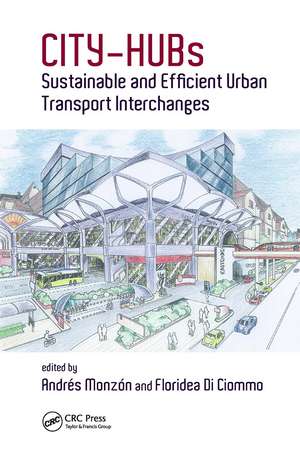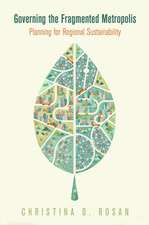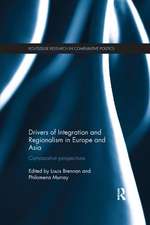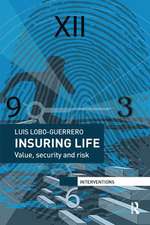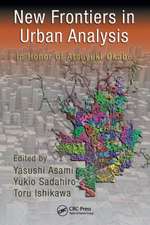CITY-HUBs: Sustainable and Efficient Urban Transport Interchanges
Editat de Andres Monzon-de-Caceres, Floridea Di Ciommoen Limba Engleză Hardback – apr 2016
Transport planners throughout the world can implement a range of policies to influence travelers’ behavior, and encourage a move to public transport to achieve urban sustainability and social inclusion. At the same time population growth and urban sprawl exert their own pressures. Quality, accessible and reliable public transport through intermodal trips provides a solution. More than 20% of current commuting trips in Europe are intermodal, and typically between 20% and 30% of trip time is spent in intermodal transfer. Interchange stations are becoming important parts of city infrastructure where people spend time on social or economic activities.
Includes Contributions from Numerous Experts in the Field
CITY-HUBs: Sustainable and Efficient Urban Transport Interchanges focuses on urban transport interchanges from more than 20 European researchers demonstrates why transport interchanges are crucial for a seamless public transport system. It is based on a broad consultation process to stakeholders of 26 interchanges in 10 different countries, and on tailored surveys to travelers in five of them. It shows travelers how to reduce the negative aspects of transfer by improving information provision and by delivering convenient services and facilities.
The book outlines the required steps from interchange planning to operation, and defines the functions, the design of the space for transfer, stay and services, and assesses the needs for different types of interchange. It introduces the evaluation of urban and economic impacts and the identification of users’ perceptions to improve interchange efficiency. The most important factors from the user point of view are safety and security, transfer conditions, information, design, services and facilities, environmental quality and comfort. These define the efficiency of the interchange from two different perspectives: as a transport node and as a place.
Packed with relevant data and offering step-by-step instruction, this book:
- Proposes innovative operating strategies for an intermodal services organization (i.e. innovative business model)
- Explores pilot and test case studies for defining interchanges good practice, and tests them in validation case studies
- Sets out urban planning guidelines for urban integration of a transport interchange
| Toate formatele și edițiile | Preț | Express |
|---|---|---|
| Paperback (1) | 461.03 lei 6-8 săpt. | |
| CRC Press – 11 ian 2019 | 461.03 lei 6-8 săpt. | |
| Hardback (1) | 1330.16 lei 6-8 săpt. | |
| CRC Press – apr 2016 | 1330.16 lei 6-8 săpt. |
Preț: 1330.16 lei
Preț vechi: 1622.15 lei
-18% Nou
Puncte Express: 1995
Preț estimativ în valută:
254.52€ • 266.46$ • 210.60£
254.52€ • 266.46$ • 210.60£
Carte tipărită la comandă
Livrare economică 05-19 aprilie
Preluare comenzi: 021 569.72.76
Specificații
ISBN-13: 9781498740845
ISBN-10: 1498740847
Pagini: 300
Ilustrații: 71 black & white illustrations, 64 black & white tables
Dimensiuni: 156 x 234 x 23 mm
Greutate: 0.54 kg
Ediția:1
Editura: CRC Press
Colecția CRC Press
Locul publicării:Boca Raton, United States
ISBN-10: 1498740847
Pagini: 300
Ilustrații: 71 black & white illustrations, 64 black & white tables
Dimensiuni: 156 x 234 x 23 mm
Greutate: 0.54 kg
Ediția:1
Editura: CRC Press
Colecția CRC Press
Locul publicării:Boca Raton, United States
Public țintă
ProfessionalCuprins
INTERCHANGE CONCEPT. Introduction. Why Interchanges? Understanding Intermodality. Interchange Places. Insights: Interchange Management and Governance. ELEMENTS OF EFFICIENT INTERCHANGES. Making a Successful Interchange in Reality. Making the Interchange Attractive for Users. The City-HUB Model. BENCHMARKING THE CITY-HUB MODEL. Cross-Cases Analysis: European Interchanges. Urban Interchanges for Efficient and Sustainable Mobility. References. Appendices.
Recenzii
"This book deals with an issue that is paramount in succeeding the shift towards better mobility practices. Better, in this context, means both user-friendly and environment-friendly mobility. Interchanges play a major role to achieve this goal. And this is precisely the scope of this book."
—Dr. Panos Tzieropoulos, EPFL - École polytechnique fédérale de Lausanne, Switzerland
"An essential reference for understanding the potential for developing the role of interchanges in different spatial contexts and for establishing consistent levels of quality, accessibility and service provision internationally."
—Iqbal Hamiduddin, The Bartlett School, UCL, London,
"Instead of being limited to specific mobility concerns, the comprehensiveness of the city-hub vision is explicit in its interdisciplinary approach to a wide spectrum of elements and issues, including governance (stakeholders, management, finance and business strategies), technological innovation, social concerns (inclusiveness and accessibility), urban land use planning and environment… a timely and useful publication to address the issues of urban interchanges by proposing a holistic and interdisciplinary "business model" approach."
-- Chia-Lin Chen, Journal of Transport Geography
—Dr. Panos Tzieropoulos, EPFL - École polytechnique fédérale de Lausanne, Switzerland
"An essential reference for understanding the potential for developing the role of interchanges in different spatial contexts and for establishing consistent levels of quality, accessibility and service provision internationally."
—Iqbal Hamiduddin, The Bartlett School, UCL, London,
"Instead of being limited to specific mobility concerns, the comprehensiveness of the city-hub vision is explicit in its interdisciplinary approach to a wide spectrum of elements and issues, including governance (stakeholders, management, finance and business strategies), technological innovation, social concerns (inclusiveness and accessibility), urban land use planning and environment… a timely and useful publication to address the issues of urban interchanges by proposing a holistic and interdisciplinary "business model" approach."
-- Chia-Lin Chen, Journal of Transport Geography
Descriere
This edited book shows how much integration is needed for maximizing efficiency in terms of coordination. It outlines steps from planning to operation, the functions and the logistics of an interchange, and its value as a social and economic hub.
Notă biografică
Andrés Monzón is a professor at Universidad Politécnica de Madrid, director of TRANSyT (Transport Research Centre), and coordinator of the City-Hub (Integrated Design of Urban Interchanges), 7FP project.
Floridea Di Ciommo is responsible for the research area on Sustainable Mobility and Travel behavior at the Center for Innovation in Transport-CENIT, Technical University of Catalonia-Barcelona Tech, and is the technical manager of City-HUB (Integrated Design of Urban Interchanges), 7FP project. Di Ciommo has worked extensively on transport and accessibility issues and socio-economic infrastructure evaluation, and is now the chair of Transport and Equity Analysis Cost Action. She has developed her experience in the evaluation of mobility patterns requirements and travel behavior analysis. Currently, she is a member of the travel behavior and value committee of Transport Research Board (i.e. ADB 10) and a member of the ECTRI mobility group.
Floridea Di Ciommo is responsible for the research area on Sustainable Mobility and Travel behavior at the Center for Innovation in Transport-CENIT, Technical University of Catalonia-Barcelona Tech, and is the technical manager of City-HUB (Integrated Design of Urban Interchanges), 7FP project. Di Ciommo has worked extensively on transport and accessibility issues and socio-economic infrastructure evaluation, and is now the chair of Transport and Equity Analysis Cost Action. She has developed her experience in the evaluation of mobility patterns requirements and travel behavior analysis. Currently, she is a member of the travel behavior and value committee of Transport Research Board (i.e. ADB 10) and a member of the ECTRI mobility group.
